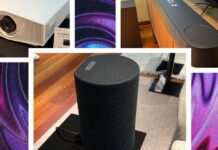I’ve long held that connected lighting is one of the most sensible smart home upgrades you can invest in — in part, because it really doesn’t need to be much of an investment. Perfectly decent smart bulbs can be had for less than the price of a pizza, and once you buy in, you’ll use them each and every day, complete with the convenience and comfort of automated lighting that you can control with your voice.
Like
- Terrific value
- Supports voice control via Alexa, Siri and Google Assistant
- Fully featured app
- Bright, good-looking white light tones, mostly accurate color quality
- Additional bulb shapes coming soon
Don’t Like
- Many color presets don’t play well with Alexa or Google
- Not compatible with Philips Hue’s apps or integrations
- Can’t trigger animated presets with voice
- No Apple HomeKit support
There’s an exception though, or an asterisk perhaps, and that’s smart bulbs that can change colors. Even as the price of LED lights fell steadily over the past five years or so, color-changing bulbs from well-established names like Philips Hue and Lifx continued to sell at a steep premium. Even if you caught a good sale, you’d be lucky in most cases to get one for anything less than $30.
Things seem to be turning a corner in 2020, though — most notably with the Philips Wiz Connected Smart Wi-Fi LED. At just $13 each, it’s a full-fledged color-changer that needs no hub, and it supports voice control via Alexa, Google Assistant or Siri Shortcuts. Its colors aren’t quite as bright or vivid as you’ll get from our top performer in the color-changing category, the Lifx Mini LED, but they still do an admirable job at splashing accurate, eye-catching shades across your walls. Despite the fact that it doesn’t work with the Philips Hue app or with Hue’s immense list of third-party integrations, the bulb still finds plenty to offer via the surprisingly well-featured Wiz app.
All of that makes these bulbs a terrific and worthy value pick if you’re interested in changing up the colors in your home — and newly announced bulb shapes like a candelabra bulb and an outdoor-rated PAR38 bulb make it easy to expand your setup to include any fixture you like. If you’re interested in deeper integrations with third-party products and services, or advanced features that can sync your lights with your TV or with your music, then you’ll still need to spend up on something from Philips Hue, Lifx or Nanoleaf — but for simple, voice-activated, color-changing light that you can control and program from your phone, these Wiz Connected bulbs will do the trick for a fraction of the cost.
Light bulb basics
For the most part, the Philips Wiz Connected LED works like any other light bulb — just screw it in and turn it on when you want light. The default setting puts out a claimed 800 lumens of brightness at a yellowy color temperature of 2,700 K. That’s the same as you’ll get from a standard 60-watt incandescent light bulb, but since this is an LED we’re talking about, the power draw is much less — just 8.5 watts.
Those energy savings are worth noting. If you turned the Philips Wiz Connected LED on at full brightness and left it on for an entire year, it’d only add a little over $8 to your energy bill. For comparison, that old-fashioned, 60-watt incandescent would add almost $60 to your bill over the same stretch. Replace a bulb like that with the Philips Wiz Connected LED, then use it for an average of three hours per day — it’ll pay for itself in energy savings in about two years, then keep on shining for another 20 years.
The Philips Wiz Connected LED (center) is about as bright as a Lifx Mini White or Philips Hue LED at its default, soft white setting — but its colors aren’t as bright as those competitors.
Ry Crist/CNET
As for the brightness, I’m still working from home without access to my lighting lab, so I can’t double-check the specific lumen count just yet. Still, in comparison with other bulbs I’ve tested in the past, including the Philips Hue White LED, it’s easy to see that the Philips Wiz Connected LED does just fine at default settings. That’s much better than the original Wiz LED, which was released before 2019, when the Hong Kong-based startup was purchased by Signify (formerly known as Philips Lighting). That bulb was too dim at its default setting, and only hit peak brightness at an awkward white light color temperature of 4,200 K.
The colors are much less bright than the white light settings, which is to be expected. What’s important is that they’re bright enough to make an impact, and for the most part, accurate in tone — though, it struggles to put out bold shades of yellow or orange. In some cases, the presets used by Alexa and Google aren’t the greatest, either. Ask either assistant for pink, for instance, and you’ll get milky white light.
Color quality is mostly accurate, but the bulb’s palette has a few weak spots.
Ry Crist/CNET
Ugly-looking pinks aside, stalwarts like red, blue and green come through just fine — and if you open the Wiz app, you’ll find a color selector with dozens of different settings, including oddball Crayola rejects like “Razzmatazz,” “Free Speech Green” and “Gorse.” What’s extra odd is that Alexa and Google seem to recognize some of these settings (including a great-looking “Deep Pink”), but not all of them. Google Assistant seemed to recognize more of them, at least, sort of. When I asked it to jump to the “Macaroni and Cheese” setting, it triggered that ugly, milky white again — but that’s better than I got from Alexa, which just looked at me funny before adding mac and cheese to my grocery list.
The app also features a number of “dynamic” color settings that cycle through various shades. Some, like “Ocean” or “Forest,” follow a theme, while others just dance between random colors for romantic mood lighting, party-appropriate dance floor lights, or a simulated candle-like flicker. My big quibble here? There’s no way to activate these with your voice or via any third-party integration. You either have to turn them on in the app, or buy a physical Wiz remote and assign them to its customizable preset buttons.
The Wiz app lets you choose between a long list of simple and dynamic color presets, as well as timed fades and a full color selector.
Screenshots by Ry Crist/CNET
An app that’s filled with tricks
With a clean interface and plenty of guidance, the Wiz app is simple enough to use — but what’s striking about it is the number of features it boasts, some of which you won’t even find in the Philips Hue or Lifx apps.
You’ll start by turning your bulb on and beginning the pairing process, which requires you to connect to the bulb’s Wi-Fi network so the app can add it onto your home network. It’s especially simple because the bulb uses its color capabilities to signal you along the way. For instance, when you set the bulb to pairing mode, it’ll start pulsing purple once its Wi-Fi network is ready for you to connect.
With the bulb up and running, you’ll specify the room it’s in and give it a name. From there, you’ll be able to turn it on and off and dim it up and own from the home screen. To change the color, tap whatever color is listed as “now playing” to pull up a full list of preset options, as well as the color selector where those oddly named shades are located. I just wish Wiz would relocate this color selector to the home screen so you don’t need an extra tap and scroll in order to pull it up.
Tapping the little gear icon pulls up the system settings, as well as the specific light settings for all of your bulbs. There are tons of neat features tucked away here, including an option to customize how long it takes for the light to fade between changes, and also an energy use tracker. You won’t get either of those with the Philips Hue app.
The Wiz app features a bounty of interesting features, including scenes, schedules, energy monitoring, automated vacation lighting, custom fade durations and a “Rhythm Mode” that lets you plot out a day’s worth of repeatable lighting changes.
Screenshots by Ry Crist/CNET
Other features include the usual options for saving scenes and for scheduling lighting changes, as well as a “Rhythm Mode” that lets you set the lights to automatically cycle between up to five custom settings at different times of the day. The app starts you off with a circadian mode that automatically adjusts the lights between energizing cool white tones when you wake up and relaxing soft white tones in the evening, with a night light for when you’re asleep. If you’d rather build your own Rhythm that automatically triggers Party Mode whenever your work-from-home day is over, hey, more power to you.
What’s especially nice about the feature is the way Wiz visualizes it with a ring-shaped timeline. Once you plot a lighting change on it — say, lights on at 7 a.m. — it’s a cinch to slide that marker around the ring to make fine adjustments to the schedule. It’s similar to the Lifx app’s Day & Dusk feature, which plots lighting changes along a line graph. I like the Wiz approach even better.
The Wiz app makes it easy to connect with third-party platforms like Alexa.
Screenshots by Ry Crist/CNET
As for integrations, the Wiz app supports Alexa, Google Assistant, IFTTT and a handful of other, smaller smart home platforms. The app does a great job of making it easy to connect with them — for instance, when you tap the option for adding Alexa, it’ll switch apps and send you directly to the authentication page in the Alexa app.
The big, missing integration is Apple HomeKit, but you can still use Siri to control these bulbs if you’re willing to use Apple’s Shortcuts app, which lets you trigger your apps with custom Siri commands. It’s a more limited experience than you get with HomeKit, which lets you program and control devices from various brands in Apple’s Home app, but it does the job. For example, I created a shortcut that turns any Wiz lights in my bedroom on just by saying, “Hey Siri, cue the lights.” That’s probably not enough for anyone who’s already seriously invested in Apple HomeKit, but it’s enough for the bulb to say that it supports voice controls by all three of the major voice assistants, so I’ll give it a passing grade.
I also appreciated the Wiz Connected privacy policy, which does a better job than most of explaining the company’s data practices in plain English. Per that policy, the only info Wiz collects when you use its bulbs are unique product identifiers and diagnostic information, as well as things like a Home ID and specific user preferences from using the app. Wiz also says that it does not share user data with any third parties for the purposes of targeted advertising.

Ry Crist/CNET
The verdict
Color-changing smart bulbs are futuristic and flashy, and they make the smart home fun. That’s why they’ve always been so much more expensive than white light smart bulbs — not because RGB diodes cost a fortune, but because they can have a dramatic impact on the way your home looks and feels. For years, manufacturers have translated that into markup, positioning full-color smart lighting as a luxury.
That’s all well and good for manufacturers, but look back through the last five years of smart home coverage on our site and on others, and count how many times we’ve used pictures of bedrooms and living rooms lit with fancy colors to connote the connected living space. It’s an easy visual for the fun futurism of the smart home, and it’s become one of the first things people imagine when they envision the category as a whole. In other words, these things shouldn’t be seen as a luxury any longer. For many, they’re a staple of the smart home experience.
The Philips Wiz Connected Smart Wi-Fi LED reflects that reality better than any other color-changing smart bulb I’ve tested to date. At $13 each, it’s as affordable as the smart home gets, and with no need for a hub, you can connect it with Alexa, Google or Siri as soon as you screw the thing in. That makes it an excellent pick for beginners, and also a great choice for anyone who’s already invested in a voice-controlled smart home, and who would enjoy expanding the setup to include a fresh pop of color or two.








